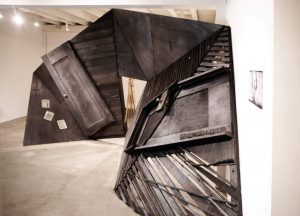
BAF Gallery, Vancouver, 2017
This BAF work in particular might be viewed as simultaneously a construction and destruction, as creating any inhabitable space is simultaneously a constructive and destructive process. Good examples are building site preparation and landscaping, the temporary use of concrete formwork, scaffolding, and such. As well, one could extend this to the materials of construction, like the harvesting and milling of wood, the creation of glass, concrete, metal etc. One could extend this simultaneity further to things like time (curing versus aging), and weather (drying versus rotting). Another layer of constructive and destructive tides is the way we inhabit specific spaces, which can often change over time. Renovating, birth of children, kids leaving home, making a space an income producer, clearing out, taking in… all such activities will change the space.
I think the rough-hewn or deconstructed aspect of much of my work – which I intend to be expressed in my digital as well as analogue works – arises integrally from my methods. Working with found materials, where I am viscerally attracted to the pattern, texture, form of pre-existing things – the interrupted processes and their traces; my embrace of improvisation, play, contradiction and complexity; my choice to charr the surface of the physical work; my embrace of non-sense and non rational logics; as well as relishing “the crack in everything”: all such stances contribute to an acceptance of allowing the work to be “itself”. Surprising, incomplete, in process, messy, rough, misshapen.
Also, like all physical works, collage and sculptural works have a context, they are not created in a vacuum. And if they are of a certain scale, this accommodation of a contextual system rubs up against real world limitations, which in turn instructs the form. The work needs to accommodate the reality of carrying the load of itself, which means dealing with gravity, tensile and compressive forces and the joining of and interfacing of materials. If the work is sited outside, one needs to additionally account for aspects like rain, temperature variance, wear and tear, unexpected human interaction. Such forces are simultaneously practical and conceptual.
A key difference between digital and analogue spheres is that many of the rules of these physical realities – such as gravity, weathering, weather – rarely apply in the digital realm. Or if they do, it requires another whole layer of digital craft and digital intentionality. As I did in other architecturally scaled works such as “Blow24fps”, and “falling: catching”, for this BAF work I have established an overall structural ordering system, which I am playing within and with. Physically, as well as digitally. Producing an unusual dynamic and friction.